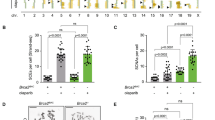Abstract
As there is now evidence that an eukaryote chromosome is composed of a single molecule of double-stranded DNA1,2, sister chromatid exchanges (SCEs) detectable in mitotic chromosomes of higher organisms can be regarded as a kind of recombination between two homologous DNA duplexes. The SCE formation is readily enhanced by exogenous agents such as ultraviolet light and chemical mutagens and seems to be closely related to post-replicational repair process in mammalian cells3. Precise knowledge about the time and sites of the SCE formation might help greatly to understand the mechanism underlying this phenomenon and its biological significance. Previous attempts3 to pinpoint cellular phases in which this recombination process is initiated have been hampered by the usage of 3H-thymidine which, although indispensable for the demarcation of sister chromatids, would cause strand scissions at any cellular phases.
This is a preview of subscription content, access via your institution
Access options
Subscribe to this journal
Receive 51 print issues and online access
$199.00 per year
only $3.90 per issue
Buy this article
- Purchase on Springer Link
- Instant access to full article PDF
Prices may be subject to local taxes which are calculated during checkout
Similar content being viewed by others
References
Laird, C. D., Chromosoma, 32, 378–406 (1972).
Kavenoff, R., and Zimm, B. H., Chromosoma, 41, 1–27 (1973).
Kato, H., Expl Cell Res., 82, 383–390 (1973); 83, 55–62; 85, 239–247 (1974); Nature, 249, 552–553 (1974); 251, 70–72 (1974).
Latt, S. A., Proc. natn. Acad. Sci. U.S.A., 70, 3395–3393 (1973); Science, 185, 74–76 (1974).
Perry, P., and Wolff, S., Nature, 251, 156–158 (1974).
Regan, J. D., Setlow, R. B., and Ley, R. D., Proc. natn. Acad. Sci. U.S.A., 68, 708–712 (1971).
Ben-Hur, E., and Elkind, M. M., Biophys. J., 12, 636–647 (1972).
Verly, W. G., Paquette, Y., and Thibodeau, L., Nature new Biol., 244, 67–69 (1973).
Whitehouse, H. L. K., Nature, 199, 1034–1040 (1963).
Holliday, R., Genet. Res., 5, 282–304 (1964).
Sigal, N., and Alberts, B., J. molec. Biol., 71, 789–793 (1972).
Author information
Authors and Affiliations
Rights and permissions
About this article
Cite this article
KATO, H. Possible role of DNA synthesis in formation of sister chromatid exchanges. Nature 252, 739–741 (1974). https://doi.org/10.1038/252739a0
Received:
Issue Date:
DOI: https://doi.org/10.1038/252739a0
This article is cited by
-
Cell cycle-dependent expression of the mouseRad51 gene in proliferating cells
Molecular and General Genetics MGG (1996)
-
Isolation of temperature-sensitive CHO-K1 cell mutants exhibiting chromosomal instability and reduced DNA synthesis at nonpermissive temperature
Somatic Cell and Molecular Genetics (1990)
-
Influence of pulsing electromagnetic field on the frequency of sister-chromatid exchanges in cultured mammalian cells
Experientia (1987)
-
Isolation of temperature-sensitive mouse FM3A cell mutants exhibiting conditional chromosomal instability
Somatic Cell and Molecular Genetics (1986)
-
On the mechanism of differential Giemsa staining of bromodeoxyuridine-substituted chromosomes
Human Genetics (1985)
Comments
By submitting a comment you agree to abide by our Terms and Community Guidelines. If you find something abusive or that does not comply with our terms or guidelines please flag it as inappropriate.



